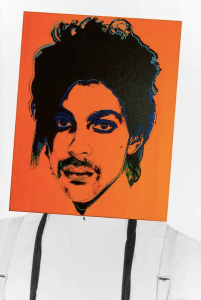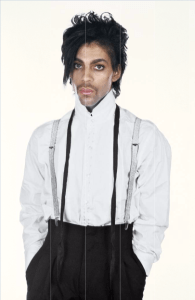
 Lynn Goldsmith is a professional photographer who rose to fame in the 1970’s for her portrait photography, especially for her work with musicians and other entertainers. Her work has appeared on over 100 album covers. In 1981, Goldsmith took this publicity photo of Prince:
Lynn Goldsmith is a professional photographer who rose to fame in the 1970’s for her portrait photography, especially for her work with musicians and other entertainers. Her work has appeared on over 100 album covers. In 1981, Goldsmith took this publicity photo of Prince:

In 1984, Goldsmith granted Vanity Fair a license to use the publicity photograph in exchange for a fee. Andy Warhol needs no introduction. His work, particularly his silkscreen portraits, is instantly recognizable. In 1984, Warhol created a series of 16 silkscreen portraits of the late musician Prince, one of which is depicted below:

Now, more than 30 years after Warhol originally created the Prince series, Goldsmith is claiming that Warhol’s Prince series infringes her copyrights in the publicity photo. In April, The Andy Warhol Foundation for the Visual Arts, Inc. (“The Warhol Foundation”) sued Goldsmith in the Southern District of New York seeking a declaratory judgment that: (i) Andy Warhol’s series of Prince silkscreens (a) do not infringe Goldsmith’s copyright because they do not copy the publicity photo and are not derivative works; and (b) constitute fair use because they transform Goldsmith’s underlying photography; and (ii) Goldsmith’s claims are barred by the statute of limitations and/or laches.
A “derivative work” is defined in the Copyright Act as “a work based upon one or more preexisting works, such as a[n] … art reproduction.” A work is considered “transformative” if it adds value to the original in the creation of new information, new aesthetics, new expression, new meaning, or new insights and understandings. A transformative work still copies from an original, but the transformative nature may be sufficient to deem the copying permissible, i.e., a fair use.
It seems obvious that Warhol’s Prince series is based on the publicity photo. In fact, in its complaint, The Warhol Foundation even admits that Warhol’s Prince series was inspired by Goldsmith’s publicity photograph. Yet, The Warhol Foundation is still seeking declaratory judgment that the Prince series is not a copy or derivative work of the publicity photo. Because Warhol had access to the publicity photo, the real inquiry is whether Warhol copied any protectable expression. In this regard, The Warhol Foundation devotes 4 pages in its complaint to pointing out all of the differences between the Prince series and the publicity photo, such as the lines on Prince’s face, the angle of Prince’s face, and the amount of eye makeup Prince is wearing and appears to be setting this up for a defense of fair use under Cariou v. Prince (the artist, not the musician).
In 2013, the Second Circuit Court of Appeals held that Prince’s repurposing of Cariou’s photographs in his paintings constituted fair use, in part because of the transformative nature of Prince’s paintings. While describing what constitutes a transformative work, the Court expressly mentioned Andy Warhol’s work, “[m]uch of Andy Warhol’s work, including work incorporating appropriated images of Campbell’s soup cans or of Marilyn Monroe, comments on consumer culture and explores the relationship between celebrity culture and advertising.” Cariou v. Prince, 714 F.3d 694, 706 (2d Cir. 2013) (emphasis added). If the district court adopts this reasoning, it could be problematic for Goldsmith. On the other hand, the Second Circuit has just recently indicated that it may be more difficult to prove a work is transformative when a new work uses the original work in the same manner as the original. See TCA Television Corp. v. McCollum, 839 F.3d 168 (2d Cir. 2016) (finding that a Broadway production’s use of a portion of the “Who’s on First?” comedy routine was not sufficiently transformative).
Goldsmith has not yet filed an answer in the proceeding, but we will be watching to see how the case progresses.